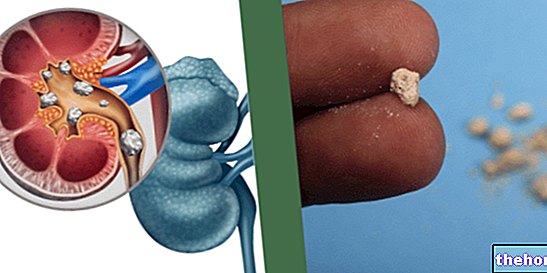Causes
Bladder cancer is caused by the abnormal development of some bladder cells, which due to genetic mutations lose their natural susceptibility to the mechanisms that regulate their growth and proliferation.
When these cells multiply giving rise to a more or less expansive neoformation we speak of benign tumors of the bladder, while when they acquire the ability to invade the surrounding tissues and organs - replacing normal cells - we speak of malignant tumors of the bladder or carcinomas bladder.
Epidemiology
Bladder cancer is the most common form of cancer affecting the urinary tract, while in the overall scenario of malignant neoplasms it represents 3-4 percent of all cases (among the most common are those of the breast, lung, colorectal and prostate). It also ranks fourth among malignant tumors affecting males and eighth among those affecting females.
Types of Bladder Cancer
Bladder cancer can affect different types of cells, influencing both the evolution of the disease and its treatment. The most common forms of bladder cancer include:
- transitional cell carcinoma (or urothelial carcinoma): this is the most common form of cancer (about 90% of cases); develops at the level of the cells that form the inner lining of the bladder wall (mucous membrane consisting of a transitional lining epithelium, i.e. a tissue where the number of cell layers and their shape vary depending on whether the bladder is full or empty ). The same cell typology also covers the internal walls of the urethra and uteri, which represent further sites potentially subject to the development of this tumor form.
- Squamous cell carcinoma: involves flat, thin cells that can form in the bladder in response to a long infectious or irritative process. As we will see later, this tumor form mainly affects areas of the planet where some parasitic infestations (schistosomiasis) are common.
- Adenocarcinoma (1-2% of cases): originates from cells belonging to the glandular component of the bladder; this form of cancer is also quite rare in our country.
Symptoms
To Learn More: Bladder Cancer Symptoms
Unfortunately, as with most malignancies, there are no early symptoms specific to bladder cancer. Among the most common, we remember first of all hematuria (blood in the urine), followed by pollakiuria (frequent urination), stranguria (painful urination), tenesmus (feeling of incomplete emptying of the bladder), intermittent urination, urinary tract infections and abdominal pain and / or in the lower back. As regards the presence of blood in the urine, which is the onset symptom in 80% of cases, most of the time the bleeding is visible to the naked eye; as such it gives the urine a bright red or rusty red color, often mixed with clots. All these symptoms are also common to other urological diseases, such as benign prostatic hypertrophy, urinary lithiasis and prostatic infections associated with sexually transmitted diseases.
In some patients, bladder cancer can remain completely asymptomatic until very advanced stages.
Risk factors
Bladder cancer prefers men, with a mashi / female ratio of 3: 1. The incidence of this neoplasm tends to increase with age, it is high in the 6th and 7th decade of life, while it is very low before the age of forty.
In addition to gender and age, bladder cancer is associated with numerous risk factors. Ethnicity, for example, sees Caucasians significantly more exposed, with a 2: 1 ratio compared to blacks. The risk of developing bladder cancer is also twice as high in smokers as in non-smokers, especially for those who are long-term and consume 10 or more cigarettes per day. Therefore, of all the correctable risk factors, smoking is certainly the most important.
The increased risk of bladder cancer is correlated to numerous industrial and occupational processes that expose the worker to polycyclic aromatic hydrocarbons, such as 2-naphthylamine and 4-aminobiphenyl. Therefore, workers in the textile and dyes industry run a greater risk. , rubber and leather, along with miners, chimney sweeps, hairdressers and applicators of preservatives and pesticides. However, it must be said that in recent decades the use of these substances has been progressively reduced and regulated by law.
Another well-documented risk factor - especially for squamous cell carcinoma - is bladder infections due to Schistosoma Haematobium (parasite endemic in countries such as Tanzania, Malawi, Egypt, Iraq, Kuwait, etc.). In our latitudes, the risk is increased by other types of urinary inflammation, chronic or repeated, common for example in paraplegics and in patients with catheterization or with a history of kidney stones.
Patients undergoing treatment with cyclophosphamide and ifosfamide-based chemotherapy drugs are at increased risk of developing bladder cancer; the same goes for patients undergoing radiation therapy for cervical cancer.
Some drugs once commonly used are also implicated in the onset of bladder cancer, in particular those based on phenacetin (an analgesic no longer used and replaced by paracetamol). Finally, as regards the diet, it seems to represent a potential factor aggravating the excessive consumption of fats, coffee and artificial sweeteners (in particular saccharin and cyclamates), and a protective factor is an adequate intake of liquids, vitamin C, vitamin A and carotenoids.
In conclusion, it is plausible that many bladder cancer episodes are induced by carcinogens associated with environmental factors and favored by a certain genetic predisposition.
Other articles on "Bladder Cancer"
- Bladder Cancer: Diagnosis and Treatment
- Bladder Cancer - Bladder Cancer Drugs




























